That's my cue...
What I have for you,
Babinio74, yes you, is a Beginners Tutorial with a target audience of someone who has never used the command line that takes you from installation of the FreeBSD Base System to a fully functional Fluxbox Window Manager FreeBSD desktop using ports to compile third party programs.
You can substitute pkg for ports by referencing the FreeBSD Handbook for instruction, still follow the basic outline and acquire some valuable command line experience in doing so.
I'm going to guide you though the process of getting a fully functional FreeBSD 13.0-RELEASE desktop up and running, complete with system files and security settings, step-by-step as if you've never used UNIX or the command line. Now let's get started: Insert your boot media and at the Welcome...

forums.freebsd.org
You'll have to figure out your video driver issues as that's outside the scope of the tutorial, but once at the DE/WM of your choice there are System and Security files that require editing. I provide examples of doing so, a
pf firewall ruleset for general desktop use and an adaptation for people who use CUPS.
I would have played you some Cake but was overcome by Infectious Grooves.
There are 12 individual pages of FreeBSD forum member screenshots showing different DE and WM in use and over 50 wallpapers on my site to help make up for it.
And it's all free!
thank you very much for your support to FreeBSD beginners !!!
That's my cue...
What I have for you,
Babinio74, yes you, is a Beginners Tutorial with a target audience of someone who has never used the command line that takes you from installation of the FreeBSD Base System to a fully functional Fluxbox Window Manager FreeBSD desktop using ports to compile third party programs.
You can substitute pkg for ports by referencing the FreeBSD Handbook for instruction, still follow the basic outline and acquire some valuable command line experience in doing so.
I'm going to guide you though the process of getting a fully functional FreeBSD 13.0-RELEASE desktop up and running, complete with system files and security settings, step-by-step as if you've never used UNIX or the command line. Now let's get started: Insert your boot media and at the Welcome...

forums.freebsd.org
You'll have to figure out your video driver issues as that's outside the scope of the tutorial, but once at the DE/WM of your choice there are System and Security files that require editing. I provide examples of doing so, a
pf firewall ruleset for general desktop use and an adaptation for people who use CUPS.
I would have played you some Cake but was overcome by Infectious Grooves.
There are 12 individual pages of FreeBSD forum member screenshots showing different DE and WM in use and over 50 wallpapers on my site to help make up for it.
And it's all free!


